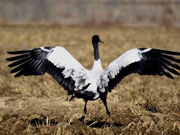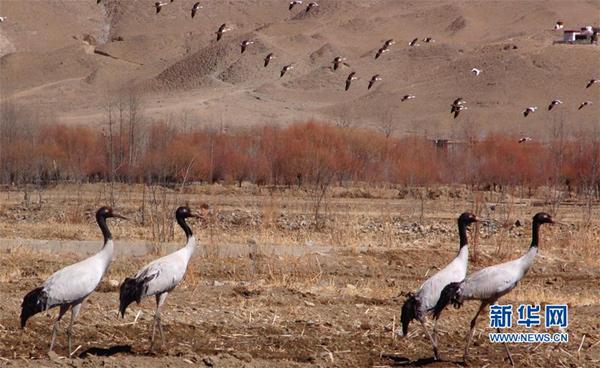Black-necked cranes flocking to Tibet

 0 Comment(s)
0 Comment(s) Print
Print E-mail CNTV, February 21, 2013
E-mail CNTV, February 21, 2013
Black-necked cranes are an endangered species with an estimated population of only around 10,000, usually found on the Tibetan Plateau and parts of India and Bhutan. But over the past decades, there has been a significant increase in the number of black-necked cranes wintering in Tibet.
 |
|
Black-necked cranes are an endangered species with an estimated population of only around 10,000, usually found on the Tibetan Plateau and parts of India and Bhutan. |
This is the Black-Necked Crane National Reserve in Linzhou County of Lhasa. Every year, thousands of cranes fly to the valleys of the Yarlung Tsangpo River on the Tibetan Plateau to spend the winter.
43-year-old Dun Zhu Ci Ren is no stranger to the cranes in this marsh. As a forest ranger for the past 6 years, he patrols this area every morning.
He said, "You could only see a few cranes six or seven years ago, because people were hunting them at that time. Since we began enforcing the law more strictly, more black-necked cranes come to spend winter here. We've seen over 5,000 in our county this year."
In addition to Dun Zhu Ci Ren, there are 126 other rangers all over Tibet keeping a close watch on this endangered species.
Black-necked cranes roost at night as a group in shallow areas of streams and ponds. When the sun rises, they leave to forage, and then split into smaller groups on the feeding ground.
The cranes are usually quite wary of outsiders. But in Linzhou County, they are tolerant of humans and their livestock. They spend the winter in the farming community and live on the grain gleaned in the barley and wheat stubble fields.
Ci Ren, villager, said, "I often see the cranes on the fields. They are not scared of humans at all."
Although locals revere the cranes in their religion, the birds' feeding in the fields has resulted in farming losses. So much so that authorities in the Tibet Autonomous Region created a compensation scheme in 2006 for damage caused by the wild animal. In 2011, damage totaled 7 million yuan in compensation.
Lei Guilong, head of Foreatry department of Tibet Autonomous Region, said, "It's everyone's obligation to protect the ecology. It is necessary to compensate people when their interests are damaged. They will feel more appreciated and motivated to protect the cranes by this compensation."
And this is just part of the government's efforts to protect the crane. Wetlands are vital to the black-necked cranes' habitat, so the local authorities have implemented a Wetlands Protection Regulation to prevent their destruction and give the cranes more space to live.
Dawa Tsering, professor of Tibet Academy of Social Sciences, said, "Lhasa is experiencing urbanization, and the Wetlands Protection Regulation will effectively limit the unnecessary expansion of buildings, roads and infrastructures."
About 8,000 black-necked cranes now winter in Tibet, and the figure is likely to rise in the future. Efforts by the local government and residents have paid off, not only building a temporary shelter for this species, but also a lasting paradise for many generations to come.






Go to Forum >>0 Comment(s)